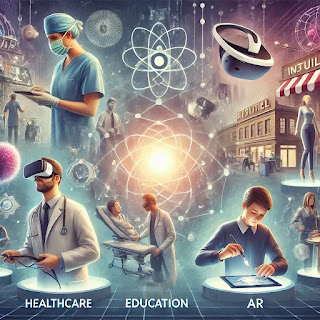Day 5: How VR, AR, and XR Are Transforming Industries
From healthcare to education, VR, AR, and XR are reshaping industries by creating innovative solutions and redefining how we interact with technology. Today, let’s explore how these technologies are making a real-world impact across different sectors.
1. Healthcare: Revolutionizing Patient Care and Training
-
Surgical Training:
- VR simulations allow medical professionals to practice complex procedures in a risk-free environment.
- Example: Osso VR provides realistic surgical training scenarios.
-
Therapy and Rehabilitation:
- VR is used to treat mental health issues like PTSD and phobias through controlled exposure therapy.
- AR applications assist physical therapy patients by providing real-time feedback on exercises.
-
Patient Education:
- XR can visualize complex medical conditions for patients, making explanations more interactive and understandable.
2. Education: Enabling Immersive Learning
-
Virtual Field Trips:
- Students can explore the pyramids of Egypt or the depths of the ocean without leaving the classroom.
- Example: Google Expeditions uses VR for educational adventures.
-
STEM Learning:
- AR applications help students visualize molecules, physics concepts, and more in 3D.
- Example: Merge Cube lets students hold and manipulate digital objects.
-
Special Education:
- XR provides adaptive learning environments tailored to individual student needs, helping those with learning disabilities.
3. Entertainment: Redefining Gaming and Media
-
Immersive Gaming:
- VR gaming offers fully immersive experiences with interactive environments.
- Examples: Beat Saber, Half-Life: Alyx.
-
Interactive Storytelling:
- AR and XR are being used to create dynamic, user-driven narratives in films and games.
- Example: XR-enhanced escape rooms that merge physical and digital elements.
-
Live Events:
- VR allows fans to attend concerts and sports events virtually, experiencing them as if they were there.
4. Retail: Transforming the Shopping Experience
-
Virtual Try-Ons:
- AR lets customers see how clothes, glasses, or even furniture will look before buying.
- Examples: IKEA Place app, Sephora Virtual Artist.
-
Personalized Shopping:
- Retailers use AR to provide tailored recommendations and in-store navigation.
-
Virtual Stores:
- Companies like Nike are building virtual showrooms for customers to shop in XR environments.
5. Real Estate: Enhancing Property Showcases
-
Virtual Tours:
- VR enables potential buyers to tour properties remotely.
- Example: Matterport creates 3D models of real estate for immersive exploration.
-
AR Home Staging:
- AR apps allow users to visualize how furniture and décor will look in a space.
6. Manufacturing and Engineering: Streamlining Design and Training
-
Product Design:
- XR tools let designers visualize prototypes in 3D before manufacturing.
- Example: Automotive companies use XR to test car designs virtually.
-
Worker Training:
- VR simulations train workers in high-risk jobs, such as operating heavy machinery, in a safe environment.
-
Remote Collaboration:
- Engineers and designers can collaborate on projects in real-time using AR and VR tools.
7. Tourism and Travel: Creating Virtual Adventures
-
Virtual Destinations:
- Explore landmarks and attractions through VR before booking a trip.
- Example: Marriott’s “Travel Brilliantly” campaign used VR to showcase exotic locations.
-
Cultural Preservation:
- AR apps bring historical sites to life, allowing visitors to see reconstructions of ancient landmarks.
8. Military: Advancing Training and Operations
-
Combat Simulations:
- VR is used to simulate combat scenarios for military training.
- Example: The U.S. Army uses VR to prepare soldiers for real-world situations.
-
AR for Battlefield Assistance:
- AR provides real-time data overlays for navigation, target identification, and mission planning.
The Big Picture
VR, AR, and XR are no longer just futuristic concepts; they’re actively transforming industries by solving problems, improving efficiency, and enhancing user experiences. As adoption continues to grow, these technologies will become integral to how businesses and individuals operate.
What’s Next?
In tomorrow’s post, we’ll explore how to get started with VR, AR, and XR development, offering practical advice and resources for beginners. Stay tuned!
